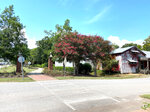FOLEY — Attainable housing, improved public places and connectivity between areas of the city are some ways to prepare Foley for the future, a new report says. Design Alabama has completed a …
This item is available in full to subscribers.
Please log in to continue |


FOLEY — Attainable housing, improved public places and connectivity between areas of the city are some ways to prepare Foley for the future, a new report says.
Design Alabama has completed a study examining Foley's needs and ways to meet upcoming challenges, said Gina Cliffod, executive director of Design Alabama. Foley was one of the Alabama cities selected for the group's Design Place program.
"Design Place is a process where we bring in a team of designers focused on your community and some of the needs that we saw in terms of planning and design that we saw as a team and also that we got from community feedback during a couple of community come and go events when we were here in February," Clifford said. "This is not just ideas from our team. These are community ideas, envisioning ideas from the community as a whole. This is what we heard."
Ben Wiesman, an owner of Place Associate and a Design Alabama board member, said the study looks at how some areas of the city could be developed in the future. The report also looks at improving connections between areas of Foley for pedestrians and vehicles.
One of the biggest things that came out of here was connectivity — walking, pedestrian and biking," Wiesman said. "You have some great parks, great places to go, but you have to drive to get there and then experience them."
"How could we still accommodate the car, but also people? We want people traversing the alley," he said. "How do we make that feel comfortable for an individual to cross that street? How do we get the sidewalk network to bump out the landscaping to begin to reinforce the pedestrian environment first with the car still having accessibility to connectivity second? We're building for people first, the car second, but still providing for everyone's needs."
Connectivity plans could use existing routes, such as alleys, the Rose Trail or Graham Creek, to provide better access around Foley.
The study includes recommendations for several areas of Foley.
Wiesman said changes for Max Griffin Park could include more aquatic activities and a stage.
"It's an older park," he said. "It's a little outdated on some ends. Some of the sports fields are no longer used as much as they once were because we've got these larger, more regional sports facilities that kids are using. How do we repurpose and recapture some of that land and reset it for the community?"
He said another addition that could be useful near the hospital is an extended-stay hotel for people staying in the area while relatives are receiving medical care.
During a public discussion of the study, several meeting participants said housing is an issue that needs to be addressed.
Wiesman said attainable housing can attract residents such as young professionals as well as older people looking for a smaller home after their children have moved out. He said many of those people cannot afford a home that cost $350,000.
"When I look at the crystal ball real estate development, I see in the next 10 or 15 years, housing will be something cities traditionally have never been a part of really, they've always just let the market address their housing needs," Wiesman said. "If cities don't start doing that themselves, they're going to be losing the race to what they can attract and how they can grow their cities."
He said some cities are changing zoning ordinances to allow smaller homes to be built on smaller lots.
"Part of it is aligning your codes and aligning your ideas to make it easy for developers to do that," he said. "What we find with economic development is that the moment there are too many roadblocks in front of somebody, they'll just go to where it's easier to do that."